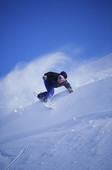
SUNDAY, Jan. 13 (HealthDay News) — Across much of the United States, the winter months are a fun time filled with falling flakes and holiday cheer. But high season for snow and ice can also entail broken bones.
Orthopedic surgeon Dr. Daryl O’Connor of Gottlieb Memorial Hospital in Melrose Park, Ill., said some of the most celebrated seasonal sports, such as skiing and sledding, give rise to a raft of visits to the emergency room.
Snowboarding, said O’Connor, is Exhibit A for outdoor sport-related injuries, with U.S. Centers for Disease Control and Prevention statistics showing that this activity alone accounts for one-quarter of all sports injury-related ER visits during winter. Half of those visits involve broken bones and sprains, often of the wrist and elbow, incurred when snowboarders fall on outstretched hands.
Sledding is another concern, causing more than 700,000 injuries a year, with 30 percent involving head injuries following collisions. Hockey and ice-skating lacerations coupled with neck, shoulder and knee injuries are another problem as players make unfortunate contact with ice, pucks, blades and other players.
And then there’s skiing, which can pound and punish the knees.
But O’Connor reserves his biggest beef for an activity you won’t find in the Olympics anytime soon: “skitching.”
“This is not even a sport,” he said in a Loyola University Health System news release, as he describes adrenaline-chasing teens who surreptitiously latch on to the rear bumper of a car so they can be pulled down icy streets on foot, in inner tubes or on sleds.
“It’s just being foolish,” O’Connor said. “In addition to broken bones, neck and shoulder injuries, young people can suffer fatal head trauma. Please, resist the skitch at all costs.”
More information
For more on sports-related injuries, visit the American Association of Neurological Surgeons.

